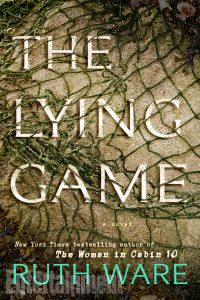Famous for her suspenseful story weaving and impeccable character development, Ruth Ware delivers another thought-provoking tale of four best friends who shared an experience as teenagers that still haunts them as women. Ware, whose books “The Woman in Cabin 10″ and “In a Dark, Dark Wood“ have been on The New York Times best-seller list, is widely known for her believable characters, tingling suspense and surreal sense of place.

Photo courtesy: Entertainment Weekly
“The Lying Game” centers around Salten, a traditional boarding school community in a marshy, quaint village near the English Channel. Estranged best friends Fatima, Thea and Isabel reunite in Salten after receiving a desperate text from Kate, their friend who grew up in Salten and opened her home to the group during holidays and weekends in their school days. The text, “I need you,” brings the friends together again just after a dead body is discovered in the marsh near Kate’s family home. The friends share not only their experiences at Salten House boarding school but also the haunting repercussions of a game they played as teens. The Lying Game is simple. Tell a lie. Stick to it. Don’t get caught. Never lie to each other. Though the girls played this game for many years, one lie went too far. When a body is discovered in the marshy area near Kate’s home, the friends must decide how far this childhood game will go.
Isa, the story’s narrator, is a new mother, which is a new type of character for Ware to showcase. Throughout the story, Isa is conflicted between her responsibility to protect her newborn daughter from the treacherous past in Salten and her allegiance to her best friends, who need her there. Fatima, a recently devoted Muslim, is a mother of two with a full-time career. Thea, a casino worker and avid drinker, was the brazen creator of the Lying Game. Kate, a financially unstable artist, still lives in the broken home where memories sweep through the creaking beams like a coastal breeze.
When the women arrive at Kate’s childhood home, Isa immediately starts feeling antsy. The Mill, Kate’s ramshackle family home, serves as an ominous symbol of destruction. Isa often feels wrong-footed throughout the story as she encounters people from her past such as Kate’s stepbrother, Luca. As the story flips between the present tension and hazy flashbacks, readers uncover the suspicious disappearance of Kate’s father, who also served as the art teacher at Salten’s boarding school. As the friends spend time reconnecting, mysterious things start happening at the house. Isa, Kate, Thea and Fatima attend a class reunion at Salten House, during which they are reminded of how truly separated they became from the place after Kate’s father went missing and the girls were abruptly expelled.
Ware writes of the friends, “When you define yourself by walls, who’s in, who’s out. The people on the other side of the wall become, not just them, but them. The outsiders. The opposition. The enemy.” As tensions build, readers are left uncertain as to who the enemy really might truly be.
Between the deterioration of the Mill to the changes in the people whom she loved, the place Isa called home is nothing like it once was. Presented with memories mixed up by the fog of drunken summer days and the incalculable number of lies, readers are left wondering throughout the story which characters can truly be trusted. In her beloved way, Ware unravels a spooky recollection of years past with every ounce of nostalgia needed to blur the lines between flashbacks and the present. Famous for her ability to weave exceptionally relatable characters into outrageous stories, Ware leaves readers wondering where the line between fact and fantasy can be drawn. Much like her other novels, “The Lying Game” keeps readers entertained until the very end.






